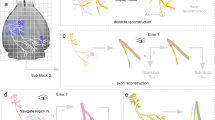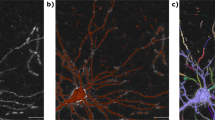Abstract
The reconstruction of neuron morphology allows to investigate how the brain works, which is one of the foremost challenges in neuroscience. This process aims at extracting the neuronal structures from microscopic imaging data. The great advances in microscopic technologies have made a huge amount of data available at the micro-, or even lower, resolution where manual inspection is time consuming, prone to error and utterly impractical. This has motivated the development of methods to automatically trace the neuronal structures, a task also known as neuron tracing. This paper surveys the latest neuron tracing methods available in the scientific literature as well as a selection of significant older papers to better place these proposals into context. They are categorized into global processing, local processing and meta-algorithm approaches. Furthermore, we point out the algorithmic components used to design each method and we report information on the datasets and the performance metrics used.
Similar content being viewed by others
Notes
We do not report further details on these two datasets since they are not neuronal images datasets.
The interested readers may refer to equations 6 and 7 in (Al-Kofahi et al. 2002) for the formal presentation of this step.
References
Al-Kofahi, K., Lasek, S., Szarowski, D.H., Pace, C.J., Nagy, G., Turner, J.N., Roysam, B., & et al. (2002). Rapid automated three-dimensional tracing of neurons from confocal image stacks. IEEE Transactions on Information Technology in Biomedicine, 6(2), 171–187.
Ascoli, G.A. (2008). Neuroinformatics grand challenges. Neuroinformatics, 6(1), 1–3.
Bas, E., & Erdogmus, D. (2011). Principal curves as skeletons of tubular objects. Neuroinformatics, 9(2-3), 181–191.
Basu, S., Tsang, O.W., & Racoceanu, D. (2014). Improved marked point process priors for single neurite tracing. In 2014 International Workshop on Pattern Recognition in Neuroimaging (pp. 1–4): IEEE.
Boykov, Y., Veksler, O., & Zabih, R. (2001). Fast approximate energy minimization via graph cuts. IEEE Transactions on Pattern Analysis and Machine Intelligence, 23(11), 1222–1239.
Chen, H., Xiao, H., Liu, T., & Peng, H. (2015). Smarttracing: self-learning-based neuron reconstruction. Brain Informatics, 2(3), 135–144.
Choromanska, A., Chang, S.F., & Yuste, R. (2012). Automatic reconstruction of neural morphologies with multi-scale tracking. Frontiers in neural circuits 6.
Chothani, P., Mehta, V., & Stepanyants, A. (2011). Automated tracing of neurites from light microscopy stacks of images. Neuroinformatics, 9(2-3), 263–278.
Chung, K., Wallace, J., Kim, S.Y., Kalyanasundaram, S., Andalman, A.S., Davidson, T.J., Mirzabekov, J.J., Zalocusky, K.A., Mattis, J., Denisin, A.K., & et al. (2013). Structural and molecular interrogation of intact biological systems. Nature, 497(7449), 332–337.
Dietenbeck, T., Varray, F., Kybic, J., Basset, O., & Cachard, C. (2014). Neuromuscular fiber segmentation through particle filtering and discrete optimization. In SPIE Medical Imaging, International Society for Optics and Photonics (pp. 90,340B–90,340B).
Dijkstra, E.W. (1959). A note on two problems in connexion with graphs. Numerische Mathematik, 1(1), 269–271.
Donohue, D.E., & Ascoli, G.A. (2011). Automated reconstruction of neuronal morphology: an overview. Brain Research Reviews, 67(1), 94–102.
Engel, A., & Van den Broeck, C. (2001). Statistical mechanics of learning: Cambridge University Press.
Frangi, A.F., Niessen, W.J., Vincken, K.L., & Viergever, M.A. (1998). Multiscale vessel enhancement filtering. In Medical Image Computing and Computer-Assisted Interventation MICCAI 1998 (pp. 130–137): Springer.
Gala, R., Chapeton, J., Jitesh, J., Bhavsar, C., & Stepanyants, A. (2014). Active learning of neuron morphology for accurate automated tracing of neurites. Frontiers in neuroanatomy 8.
Gillette, T.A., Brown, K.M., & Ascoli, G.A. (2011). The diadem metric: comparing multiple reconstructions of the same neuron. Neuroinformatics, 9(2-3), 233–245.
Glaser, E., & Van der Loos, H. (1965). A semi-automatic computer-microscope for the analysis of neuronal morphology. IEEE Transactions on Biomedical Engineering (1), 22–31.
Gu, L., & Cheng, L. (2015). Learning to boost filamentary structure segmentation. In Proceedings of the IEEE International Conference on Computer Vision (pp. 639–647).
Halavi, M., Hamilton, K.A., Parekh, R., & Ascoli, G.A. (2012). Digital reconstructions of neuronal morphology: three decades of research trends. Frontiers in neuroscience 6.
Hastie, T., & Stuetzle, W. (1989). Principal curves. Journal of the American Statistical Association, 84(406), 502–516.
Herculano-Houzel, S. (2009). The human brain in numbers: a linearly scaled-up primate brain. Frontiers in human neuroscience 3.
Lee, P.C., Ching, Y.T., Chang, H., & Chiang, A.S. (2008). A semi-automatic method for neuron centerline extraction in confocal microscopic image stack. In 2008. ISBI 2008. 5th IEEE International Symposium on Biomedical Imaging: From Nano to Macro (pp. 959–962): IEEE.
Lee, P.C., Chuang, C.C., Chiang, A.S., & Ching, Y.T. (2012). High-throughput computer method for 3d neuronal structure reconstruction from the image stack of the drosophila brain and its applications. PLoS Computer Biology, 8(9), e1002,658.
Lichtman, J.W., & Denk, W. (2011). The big and the small: challenges of imaging the brain’s circuits. Science, 334(6056), 618–623.
Liu, Y. (2011). The diadem and beyond. Neuroinformatics, 9(2), 99–102.
Mayerich, D., Bjornsson, C., Taylor, J., & Roysam, B. (2012). Netmets: software for quantifying and visualizing errors in biological network segmentation. BMC Bioinformatics, 13(Suppl 8), S7.
Meijering, E. (2010). Neuron tracing in perspective. Cytometry Part A, 77(7), 693–704.
Myatt, D.R., Hadlington, T., Ascoli, G.A., & Nasuto, S.J. (2012). NeurOmantic–from semi-manual to semi-automatic reconstruction of neuron morphology. Frontiers in neuroinformatics 6.
Oh, S.W., Harris, J.A., Ng, L., Winslow, B., Cain, N., Mihalas, S., Wang, Q., Lau, C., Kuan, L., Henry, A.M., & et al. (2014). A mesoscale connectome of the mouse brain. Nature, 508(7495), 207–214.
Parekh, R., & Ascoli, G.A. (2013). Neuronal morphology goes digital: a research hub for cellular and system neuroscience. Neuron, 77(6), 1017–1038.
Peng, H., Long, F., & Myers, G. (2011). Automatic 3d neuron tracing using all-path pruning. Bioinformatics, 27(13), i239– i247.
Peng, H., Bria, A., Zhou, Z., Iannello, G., & Long, F. (2014a). Extensible visualization and analysis for multidimensional images using vaa3d. Nature Protocols, 9(1), 193–208.
Peng, H., Tang, J., Xiao, H., Bria, A., Zhou, J., Butler, V., Zhou, Z., Gonzalez-Bellido, P.T., Oh, S.W., Chen, J., & et al. (2014b). Virtual finger boosts three-dimensional imaging and microsurgery as well as terabyte volume image visualization and analysis. Nature communications 5.
Peng, H., Meijering, E., & Ascoli, G.A. (2015). From diadem to bigneuron. Neuroinformatics, 13(3), 259–260.
Schmitt, S., Evers, J.F., Duch, C., Scholz, M., & Obermayer, K. (2004). New methods for the computer-assisted 3-d reconstruction of neurons from confocal image stacks. NeuroImage, 23(4), 1283–1298.
Sethian, J.A. (1999). Level set methods and fast marching methods: evolving interfaces in computational geometry, fluid mechanics, computer vision, and materials science Vol. 3: Cambridge University Press.
Settles, B. (2012). Active learning. Synthesis Lectures on Artificial Intelligence and Machine Learning, 6(1), 1–114.
Silvestri, L., Bria, A., Sacconi, L., Iannello, G., & Pavone, F.S. (2012). Confocal light sheet microscopy: micron-scale neuroanatomy of the entire mouse brain. Optics Express, 20(18), 20,582–20,598.
Sironi, A., Lepetit, V., & Fua, P. (2015). Projection onto the manifold of elongated structures for accurate extraction. In Proceedings of the IEEE International Conference on Computer Vision (pp. 316–324).
Srinivasan, R., Zhou, X., Miller, E., Lu, J., Litchman, J., & Wong, S.T. (2007). Automated axon tracking of 3d confocal laser scanning microscopy images using guided probabilistic region merging. Neuroinformatics, 5(3), 189–203.
Sui, D., Wang, K., Chae, J., Zhang, Y., & Zhang, H. (2014). A pipeline for neuron reconstruction based on spatial sliding volume filter seeding. Computational and mathematical methods in medicine 2014.
Türetken, E., González, G., Blum, C., & Fua, P. (2011). Automated reconstruction of dendritic and axonal trees by global optimization with geometric priors. Neuroinformatics, 9(2-3), 279–302.
Türetken, E., Benmansour, F., & Fua, P. (2012). Automated reconstruction of tree structures using path classifiers and mixed integer programming. In 2012 IEEE Conference on Computer vision and pattern recognition (CVPR) (pp. 566–573): IEEE.
Türetken, E., Benmansour, F., Andres, B., Pfister, H., & Fua, P. (2013). Reconstructing loopy curvilinear structures using integer programming. In Proceedings of the IEEE Conference on Computer Vision and Pattern Recognition (pp. 1822–1829).
Vasilkoski, Z., & Stepanyants, A. (2009). Detection of the optimal neuron traces in confocal microscopy images. Journal of Neuroscience Methods, 178(1), 197–204.
Wang, Y., Narayanaswamy, A., Tsai, C.L., & Roysam, B. (2011). A broadly applicable 3-D neuron tracing method based on open-curve snake. Neuroinformatics, 9(2-3), 193–217.
Xiao, H., & Peng, H. (2013). App2: automatic tracing of 3d neuron morphology based on hierarchical pruning of a gray-weighted image distance-tree. Bioinformatics, 29(11), 1448–1454.
Yang, J., Gonzalez-Bellido, P.T., & Peng, H. (2013). A distance-field based automatic neuron tracing method. BMC Bioinformatics, 14(1), 93.
Yuan, X., Trachtenberg, J.T., Potter, S.M., & Roysam, B. (2009). Mdl constrained 3-D grayscale skeletonization algorithm for automated extraction of dendrites and spines from fluorescence confocal images. Neuroinformatics, 7 (4), 213– 232.
Zhang, Y., Zhou, X., Degterev, A., Lipinski, M., Adjeroh, D., Yuan, J., & Wong, S.T. (2007). A novel tracing algorithm for high throughput imaging: Screening of neuron-based assays. Journal of Neuroscience Methods, 160(1), 149–162.
Zhao, T., Xie, J., Amat, F., Clack, N., Ahammad, P., Peng, H., Long, F., & Myers, E. (2011). Automated reconstruction of neuronal morphology based on local geometrical and global structural models. Neuroinformatics, 9(2-3), 247–261.
Zhou, Y., & Toga, A.W. (1999). Efficient skeletonization of volumetric objects. IEEE Transactions on Visualization and Computer Graphics, 5(3), 196–209.
Zhou, Z., Liu, X., Long, B., & Peng, H. (2015a). Tremap: Automatic 3d neuron reconstruction based on tracing, reverse mapping and assembling of 2d projections. Neuroinformatics, 1–10.
Zhou, Z., Sorensen, S.A., & Peng, H. (2015b). Neuron Crawler: An automatic tracing algorithm for very large neuron images. In ISBI.
Acknowledgments
The Authors are grateful to the anonymous referees for their valuable comments which greatly helped to improve the first version of this paper.
Author information
Authors and Affiliations
Corresponding author
Ethics declarations
Conflict of interests
None declared. All the authors are supported by University Campus Bio-Medico of Rome.
Rights and permissions
About this article
Cite this article
Acciai, L., Soda, P. & Iannello, G. Automated Neuron Tracing Methods: An Updated Account. Neuroinform 14, 353–367 (2016). https://doi.org/10.1007/s12021-016-9310-0
Published:
Issue Date:
DOI: https://doi.org/10.1007/s12021-016-9310-0




